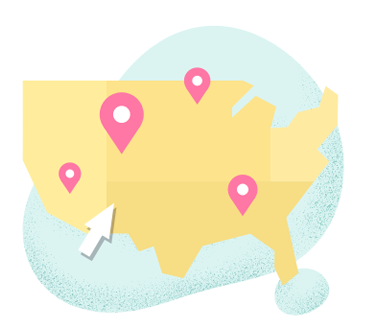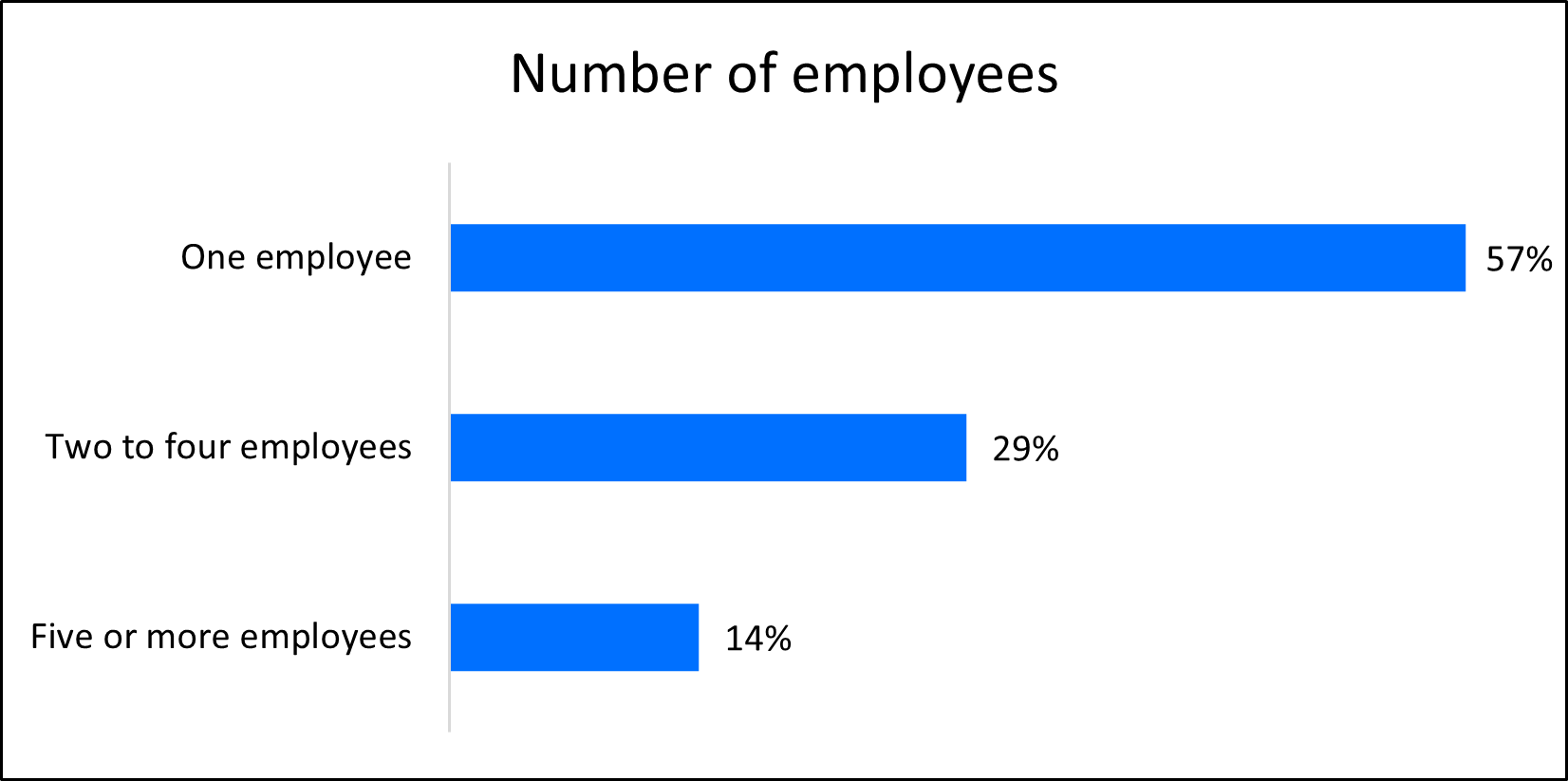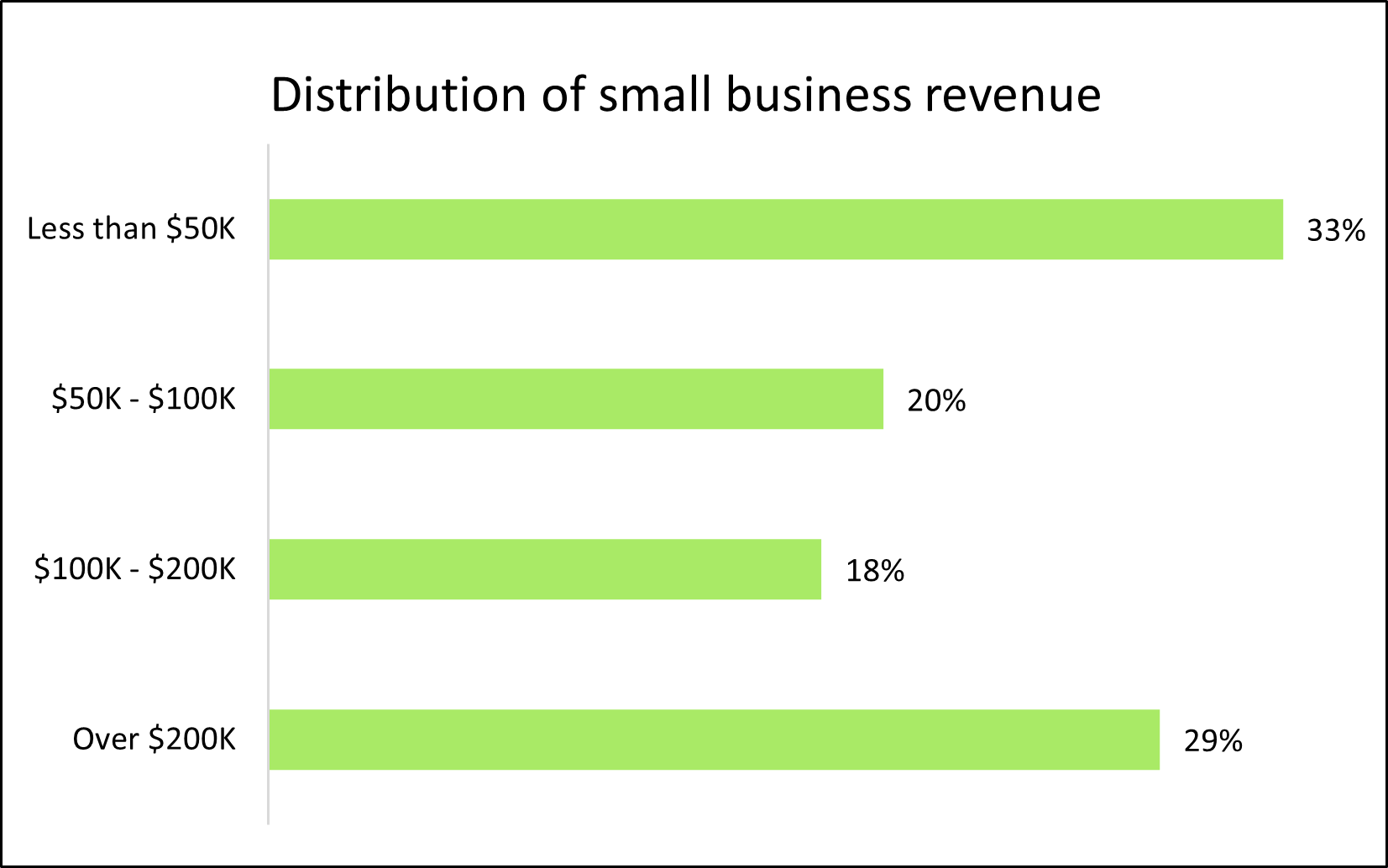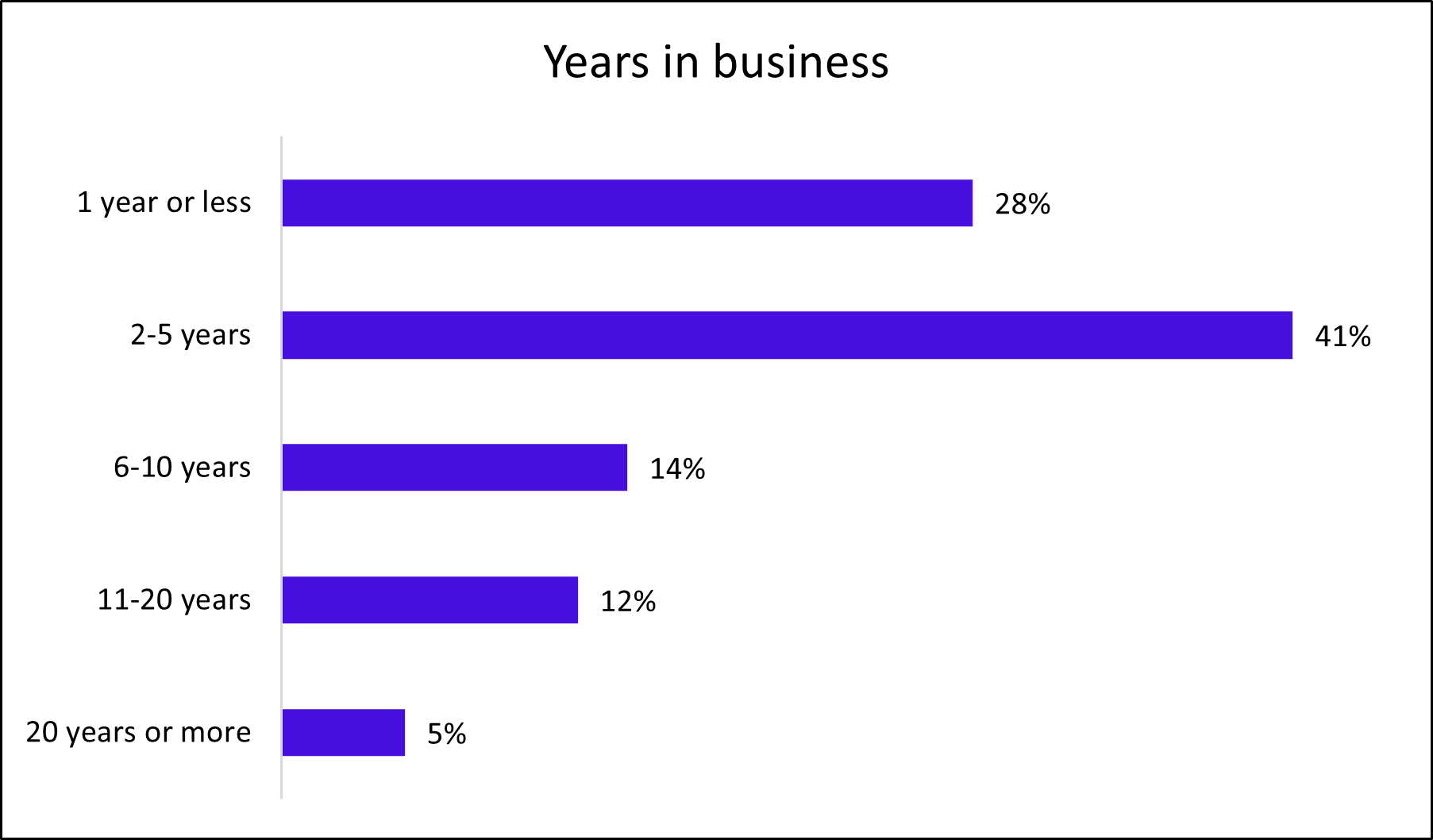Small business insurance costs
The cost of small business insurance primarily depends on which policies you buy. The most common policy, general liability insurance, has an average cost of $42 per month.
What do small businesses pay for small business insurance?
Each insurance policy covers specific risks, and you'll pay more for insurance when your business is likely to encounter these risks. In general, the more likely that you'll have to make an insurance claim, the more expensive the cost of coverage will be.
For example, general liability insurance covers the costs of accidents where customers sue over bodily injury or property damage. That's why businesses that are open to the public or handle customer property pay more for this policy. Simply put, the insurance company knows the odds of a claim are higher for these businesses, so it charges more to make up for it.
Or, if you hire more employees you’ll pay more for workers’ compensation insurance, which covers work injuries.
Overall, business insurance costs more for companies with:
- A large rented or owned space
- Frequent public interaction, such as a retail store
- More employees
- A history of claims, or an industry with a history of claims
Let's dig a little deeper into insurance costs for different policies.
Average monthly small business insurance costs
Insurance premiums vary based on the business insurance policies a business buys. Below are the average monthly premium costs for some of the most common types of insurance policies.
These estimates were derived from the median cost of thousands of insurance policies purchased by TechInsurance's small business customers from leading insurance providers. The median cost offers a more accurate estimate of what your business is likely to pay than the average cost of business insurance because it excludes outlier high and low premiums.
Insurance policy | Average monthly cost |
|---|---|
$42 / month | |
$45 / month | |
$61 / month | |
$145 / month | |
$67 / month | |
$57 / month | |
$147 / month | |
$75 / month |

Understanding factors that impact small business insurance costs
Factors that affect insurance premiums include:
- Policy limits and deductible
- Industry/profession risks
- Company size
- Business location
- Number of employees
Other factors also play a role, such as which insurance company you choose. For example, two insurance companies may charge different rates for the same amount of general liability coverage.
How do policy limits and the deductible you choose impact business insurance costs?
The policy liability limits and deductible you choose will affect the premium you pay. Higher limits cost more and provide greater coverage. A higher deductible could reduce your premium, but cost more in the long run.
For example, most businesses and contractors (63%) choose errors and omissions policies with a:
- $1 million per-occurrence limit: The policy pays up to $1 million on any single claim.
- $1 million aggregate limit: The policy pays up to $1 million on all claims.
The cost of small business liability insurance also depends on the specifics of the policy.
For instance, a technology errors and omissions policy, which bundles E&O coverage with cyber insurance, will cost more since it also covers data breaches. This type of policy is especially recommended for technology companies that manage a client's cyber or network security.
How do your industry and company size influence business insurance costs?
Your line of work and its risks affect your premium. For example, computer repair technicians may pay more for general liability insurance coverage because they handle other people's property and could be blamed if something breaks.
Or, IT consultants might pay more for errors and omissions insurance because they're vulnerable to client lawsuits over the quality of their advice or professional services.
If you work in cybersecurity or an industry that handles a large volume of sensitive data, such as customer credit card numbers, expect to pay more for cyber insurance.
The size of your business also affects your level of risk and premium. Companies with more employees can expect to pay more for coverage. Find out more about business insurance costs for independent contractors and consulting businesses.
How does your business location affect business insurance costs?
If your business is located in an area with a lot of foot traffic, your level of risk increases.
For example, someone could vandalize your business, leaving you with significant property damage. In this case, a commercial property insurance policy would cover repair or replacement expenses.
Because workers’ compensation laws are set by each state, where your employees work will determine how much you pay for this policy.
For example, states with strict workers’ compensation regulations, like California or New York, have higher premiums. But you might save money if you live in a state like Texas. Texas has low insurance rates and is one of two states that don't require businesses to carry a workers' comp policy.
Almost every state requires commercial auto insurance for business-owned vehicles. This policy covers property damage and injuries if your business vehicle is involved in an accident. On average, commercial auto insurance costs $147 per month.
Which small business insurance policies does your state require?

What other factors impact business insurance costs?
The amount of coverage you choose, your industry and company size, and your location are just a few factors that affect small business insurance costs.
Insurers will also look at:
- Business property value. If you own or rent valuable commercial property, your policy's premiums will be higher compared to owning or renting a business property that is less valuable.
- Business income. In general, businesses with higher revenue are more risk-prone and thus, will pay more for insurance.
- Number of employees. It's simple: The more employees you have, the more opportunities there are for accidents and lawsuits.
- Types of business insurance purchased. Each policy has its own unique cost, with general liability insurance being the most affordable policy.
- Claims history. Companies that have made past insurance claims are considered higher risk. They will pay more for insurance than those with a clean history, which is why risk management is essential.
TechInsurance makes it easy to buy small business insurance
TechInsurance is a trusted insurance expert for small businesses, contractors, and consultants, with extensive knowledge of the IT and other sectors. We help business owners compare quotes from top-rated providers, buy policies, and manage coverage online.
By completing TechInsurance's easy online application today, you can compare free quotes for several types of business insurance policies from top-rated U.S. insurance companies. Insurance agents are available to help answer any questions you may have on the different types of coverages.
Once you find the right policies for your small business, you can begin coverage in less than 24 hours and get a certificate of insurance for your small business.
Hear from business owners like you who purchased insurance coverage.
How can you reduce the cost of small business insurance?
Property and liability insurance doesn't have to be expensive. In fact, there are several ways for your small business to save money on business insurance.
This includes:
Shopping around
Not all carriers provide the same insurance coverages and rates. That's why it's important to shop around to see which policies are the best fit for your unique business needs.
TechInsurance's licensed insurance agents are available to help you compare and select the policies from trusted carriers, such as The Hartford and Chubb, that are affordable and comprehensive.
Bundling insurance policies
Small low-risk businesses may be eligible for a business owner’s policy (BOP). A BOP bundles a general liability insurance policy with commercial property insurance and costs less than purchasing the policies separately
In addition, some small businesses may be eligible to bundle cyber insurance, also known as cyber liability insurance, with E&O insurance in a technology errors and omissions policy. Generally, this policy costs less than purchasing the coverages separately.
Making annual premium payments
You can choose to pay your insurance premiums once a month or once a year. While making a smaller payment each month requires less money up front, it may cost more in the long run since insurers often offer discounts to businesses that pay an annual premium.
Keeping continuous coverage
While it’s possible to purchase business insurance coverage when you start a project and drop it when you complete the project, this cost-cutting strategy can backfire.
A lot of insurance companies will offer more expensive insurance rates if you need to get coverage again. Also, you won't have any insurance protection between projects, meaning you'll have to pay out-of-pocket if any accidents occur.
When selecting coverage, it's important to choose policy limits that match your risk level. Higher limits will provide more protection, but they will cost more. If your level of risk is minimal, you can save money by choosing lower coverage limits since you won't need as much protection.
Choosing a higher deductible
Choosing a higher deductible is an easy way to save on your premium, but make sure to choose a deductible you can still afford. If you can’t pay your premium, you won't be able to collect on a claim.
Managing your business risks
Companies with no previous claims on their insurance can expect to pay less for business insurance. Business owners can help keep their claims history clean with a risk management plan.
This could include:
- Installation of fire alarms and fire suppression systems
- Installation of security systems, especially in high risk locations
- Company protocol that secures valuable equipment
- Open communication with clients to avoid oversights
- A formal procedure for resolving complaints
- Strict protocols for handling customer data
- Use of firewalls and other security technology to reduce cyber risk
Who is the average TechInsurance customer?
TechInsurance has helped a wide range of small business owners get insurance for their business, ranging from software developers to construction contractors, cleaning service professionals, and healthcare workers. We provide insurance coverage for small businesses across almost all industries, including the IT sector.
To get a better idea on how TechInsurance can help your business, it's helpful to understand our typical customer profile.
Most of our small business customers have:
- One to four employees
- Yearly revenue ranging anywhere from less than $50,000 to more than $200,000
- Been in business for five years or less
Most companies only have one employee
The number of workers you have at your small business will influence your business insurance costs. This is especially true for policies like workers' comp insurance.
At TechInsurance, over half (57%) of our small business customers have only one employee. This shows that a majority of our customer base are sole proprietors, independent contractors, and freelancers. Another quarter (29%) of businesses have between two to four employees.

53% of companies make less than $100,000 per year
Your annual revenue is another factor that determines your small business insurance premium. For example, small, low-risk businesses that make less than $1 million a year may be eligible for a cost-saving BOP.
At TechInsurance, the average yearly income of our small business customers is $80,000. Over half (53%) of our customers make less than $100,000 in annual revenue.

Most companies have been in business for five years or less
Companies that have been in business for several years with a clean claims history are often eligible for lower insurance premiums.
At TechInsurance, over two-thirds (69%) of our customers have been in business for five years or less.


